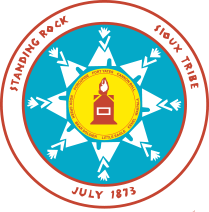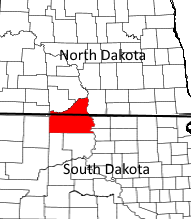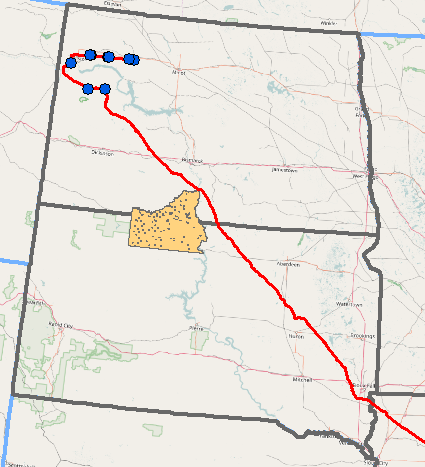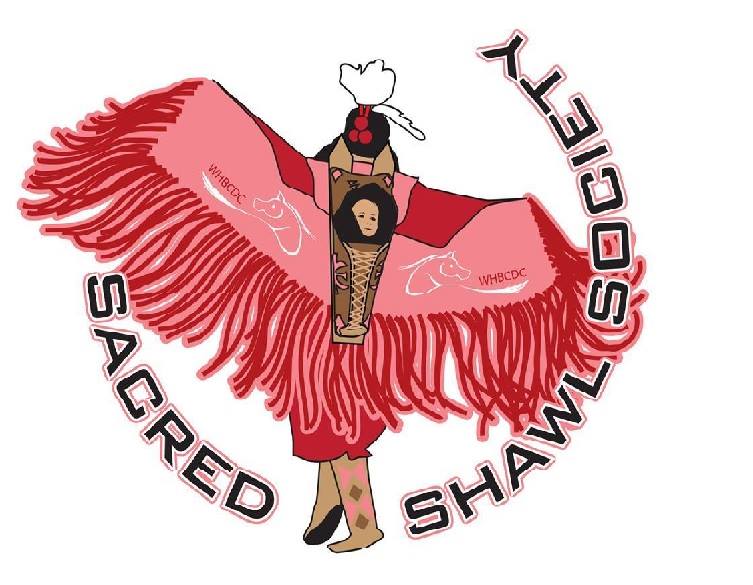Standing Rock Reservation: Sioux Nation
Sexual Assault
1860's-Today
By: Lara H.
TRIGGER WARNING: This article contains information about sexual assault and/or violence which may be triggering to survivors.
Introduction

Standing Rock Sioux Reservation is located between the border of North Dakota and South Dakota. For many years the Sioux tribe of Standing Rock have been fighting the effects of violence perpetrated within the area at the fault of colonialism and its long lasting effects. One of the most prominent forms of violence affects the Lakota women in the form of sexual assault. According to reports “one out of three Native women will be raped within her lifetime” (Robertson, 2012, p.21)1 and the Sioux women of Standing Rock are no exception to this statistic. Many Sioux women have indicated that they have experienced sexual abuse in some way, shape or form. Additionally, "many survivors reported that they had experienced sexual violence several times in their lives and by different perpetrators." (Amnesty, 2007, p.32)7 Along with the increased rates of sexual assault there is also a lack of resources to help support victims of sexual assault in the area. More times than not perpetrators are not brought to justice due to a lack of both tribal and federal police investment into the issue. Overall the sexual violence and its effects are creating a tremendous problem for the Lakota women of Standing Rock Reservation.

History of Violence for the Sioux Nation of Standing Rock
Standing Rock Sioux Reservation was first recognized by the United States government as part of the Great Sioux Reservation on April 29th, 1868. In 1889 the United States government minimized land reserved for the Great Sioux Reservation, thus shrinking the size of the six individual reservations within it. In 1959 The Standing Rock Sioux Tribe had their constitution approved and were now federally recognized by the United States government as their own sovereign nation. Actions parallel to this such as the long standing violence due to the effects of colonialism, environmental racism in form of the pipeline, or the elevated sense of masculinity due to man camps have also impacted the Standing Rock Reservation in the past and present. As a result of these events a pathway has been created that allows sexual violence such as sexual harassment, sexual assault, and rape within the Lakota Nation.8
History of Sexual Violence
Sexual assault and the victimization of the Lakota women has been plaguing the Standing Rock Reservation for many years due to the stigma of violence within the area. According to Robertson (2012) “prior to 1978 there were only three programs in the state providing advocacy for rape victims.”(p.24)1 This type of action prevents victims from getting proper services to combat the effects of sexual assault. The lack of resources also helped establish the ideology that Native victims of sexual assault were not important to the community. This ideology led to decreased reporting from victims for a variety of reasons including the thought that nothing will be done after reporting. Along with the history of lack of resources Amnesty (2007) reported that if the victim of sexual assault was a Native woman, the perpetrator typically receives a lower penalty. 7 Another major factor that influences the ideology regarding sexual assault is colonial sexual violence. An example of this shown through a video game called “Custer's Revenge” which included scenes of sexual violence against Indigenous women. This type of action helped fuel the already negative ideology revolving around Indigenous women and their perceived worth.
History of Colonial Violence
One of the main causes of increased sexual violence in the Standing Rock Reservation is the long-standing violence and conflict in the area. One of the main causes of this violence is colonialism. Horvath (1972) defines colonialism as “a form of domination -- the control by individuals or groups over territory and/or behavior of other individuals or groups.”(p.46)11 One of the main traits associated with colonialism is the introduction of settlers to an area. Colonialism and its settlers brings a state of violence and inequality to the people it encounters. Looking more specifically at Standing Rock Reservation, colonialism has brought great change to the area. According to a a report from Amnesty (2007) “prior to colonization women [in Native cultures] held esteemed positions in society.” (p.16)7 The report goes on to state that “violence against women was rare and when it occurred, was often severely punished.”(Amnesty, 2007, p.16)7 Gender-based violence became a weapon of power used by the settlers to establish the achievement of their conquest. Colonialism not only affected Sioux women individually but it also completely changed gender roles within the community. Many of the settlers would only show respect towards male members of the Sioux tribe while blatantly ignoring women of power within the Sioux community. An example from Amnesty (2007) reports that “Christian missionaries exerted pressure on Indigenous peoples to assume what their churches considered proper gender role”(p.16)7 This led to huge changes with the Sioux tribe, including changes in who held dominant positions within the tribe.
Sexual Assault at Standing Rock
Information collected by the US Department of Justice (2017) indicated that “American Indians are 2.5 times more likely to experience sexual assault crimes compared to all other races.” (para.3)9 According to the advocacy group for sexual assault, RAINN (2018), sexual assault is “sexual contact or behavior that occurs without explicit consent of the victim.” (para.2)6 This can include things like unwanted touching, fondling, or penetration of the victim (rape) as well as forcing the victim to commit sexual acts on the perpetrator. Looking at sexual assault in the lens of Sioux tribe is essential to understanding why sexual assault issue on Standing Rock Reservation. According to a report from Amnesty (2007) women from Standing Rock Reservation stated that they “could not think of any Native women within their community who had not been subjected to sexual violence." (p.2)7 When analyzing this topic one will want to look into many different aspects that perpetuate sexual assault in the Standing Rock Sioux Nation, including things like a long standing history of violence due to colonization, tension in the area due to big corporations perceived entitlement to natural resources, as well as the increased dehumanization of Lakota women of in the area.

Dakota Access Pipeline's Influence on Sexual Assault
In more recent years sexual violence has been increased due to the establishment of the Dakota Access Pipeline (DAPL).
When thinking about the DAPL it is important to take into consideration that “the history of the relationship between the Sioux Nation and the U.S. government, which many people see as a history of broken promises, early treaties that were broken to lands.” (Martin, 2016, para.28)2
The history in the area includes broken treaties, forceful removal, as well as the destruction of sacred land. The DAPL is set to run through 38 miles of land that according to the Fort Laramie Treaty still belongs that the Sioux tribe. 5
The DAPL poses great risk of contamination of the land as well as an overall destruction of the land due to construction.
The DAPL brought many people to the area, including protesters of the pipeline, police, and construction workers. The construction worker who have come to build the DAPL live in areas called man camps.
Man camps established for the DAPL near the Sioux Standing Rock Reservation this area are mostly inhabited by non-Indian men.
According to a report from Earth First (2016), man camps are “often sites of violence against and disappearances of women, particularly indigenous women.” (para. 20)10
In accordance a report from the Department of Justice stated that 86% of Indigenous women indicated that their attacker was non-Indian. 9
This means that with the increase in man camps, there is a environment that is being established that is partially fueled by the dehumanization of women in the surrounding area through sexual violence.
Many of the Lakota women in the area are finding themselves at higher risk living so close to areas where this type of violence is accepted.
Policy and Change
Tribal Law and Order Act
Over the years policy implemented by the federal government has not formally protected the Lakota women against acts of violence and more specifically sexual violence. It was as recent as 2010 that changes were made in hopes of specifically combating these violences against Indigenous women. According to Robertson (2012) the Tribal Law and Order Act (TLOA) was implemented in July of 2010 under the Obama administration due to “numerous historical moments, grassroots efforts, and indigenous struggles against settler-colonialism and heteropatriarchy.” (p.22)1 TLOA focuses on reducing rates of violence specifically for Native women. More specifically the concentration of TLOA’s Title XI is prevention of domestic violence and sexual assault. Moreover, the bill calls for specialized training for people who will be working with victims of sexual assault at both the tribal and federal level. The bill also calls for reinforced “prosecution and sentencing of perpetrators”(Robertson, 2012, p.22)1 of sexual assault.
Violence Against Women Act
Another bill was put into place to try and protect women against acts of violence; the Violence Against Women Act. This piece of legislation was originally established in 1994, but did little to protect Indigenous women due to jurisdiction issues revolving around the tribal, state, and federal police and who has jurisdiction over Native vs. non-native crimes. Due to this when Indigenous women were attacked by a non-native perpetrator tribal police were unable to make an arrest. In March of 2015 revisions were made to specifically combat the issue revolving jurisdiction. According to Mullen (2017) “VAWA grants Native Americans more power over non-native perpetrators.” (p.812)12 While the provision of VAWA helped start creating an atmosphere that increases the chance of Indigenous women receiving justice, it does so at the cost of forcing “tribal courts will conform to Anglo-American criminal procedures” 12 which in return “robbing Native Americans of their cultural uniqueness.”(Mullen, 2017, p.812)12 While VAWA has created great strives for the persecution of non-native assailants of sexual assault it creates an atmosphere which furthers the effects of colonialism within Standing Rock Reservation.

Sioux Nation Falling Through the Cracks
While there have been changes in legislation to protect Indigenous victims of sexual assault, cases especially in Standing Rock Reservation are still falling through the cracks.
According to a report from Amnesty (2007) there is “chronic under-resourcing of law enforcement and health services, confusion over jurisdiction, erosion of tribal authority, discrimination in law and practice.” (p.104)7
A report from NPR’s Laura Sullivan (2007) stated “there aren't enough police to investigate sexual assaults, and few of the cases are prosecuted.” (para.22)5
Sullivan (2007) furthered this statement with a quote from a former officer from the BIA stated that “he was too overwhelmed and overworked to keep up with the number of calls for rape, sexual assault and child abuse he received each week.” (para.28)5
This indicates that not only are the victims of sexual assault in the Sioux Standing Rock Reservation are not receiving proper care after their attack, but they are also not getting the protection and assistance from law enforcement.
Tharp (2014) discusses the lack of action from the tribal police even if the victim gets the chance to follow through with the charges.
According to Tharp (2014) “so many times it stops at the tribal level and it is forgotten about.
They keep it under wraps. I would say the majority [of cases], 75%, stop at the tribal police.” (p.26)3
Actions like this create an atmosphere where victims choose not to report in fear of nothing being done.
Furthermore actions similar to this can be seen at a federal level, it can be observed that “even if the police do pursue rape cases, these cases are typically transferred to state or federal courts, which have in the past rejected tribal cases at twice the rejection rate for all federal cases.” (Tharp, 2014, p.37)3
Overall the main issue is the lack of justice for Lakota survivors of sexual assault.
Due to this many families of victims seek out justice in their own way by committing “acts of violent retribution against accused rapists and molesters” (Tharp, 2014, p.38)3, thus further violence within the Reservation.
Jurisdiction of Tribal, Federal, and State Police
According to Amnesty (2007):
- Tribal police and prosecutors can investigate and prosecute all crimes committed by Indian individuals in areas including but not limited to Indian Country7
- Tribal police and prosecutors have concurrent jurisdiction with federal police and prosecutors (or state police and prosecutors where Public Law 280 is applied) over major crimes by Indians on tribal land.7
- Tribal police and prosecutors cannot investigate and prosecute crimes committed by non-Native perpetrators on tribal land.7
- Tribal authority to sentence offenders is limited to a maximum of one year’s imprisonment and a US$5,000 fine for each offence.7
- Federal police and prosecutors have exclusive jurisdiction to investigate and prosecute crimes committed by non-Native perpetrators in Indian Country (except where Public Law 280 is applied).7
- Federal police and prosecutors have exclusive jurisdiction to investigate and prosecute crimes committed by non-Native perpetrators in Indian Country (except where Public Law 280 is applied).7
- Federal police and prosecutors have concurrent jurisdiction with tribal police and prosecutors to investigate and prosecute major crimes committed by Indigenous people in Indian Country (except where Public Law 280 is applied).7
- Where Public Law 280 is applied, state police and prosecutors have exclusive jurisdiction to investigate and prosecute crimes committed by non-Native perpetrators on tribal land.7
- Where Public Law 280 is applied, state police and prosecutors have concurrent jurisdiction with tribal police and prosecutors to investigate and prosecute crimes committed by Indigenous perpetrators on tribal land.7
- If a crime takes place on state land, state police and prosecutors have exclusive jurisdiction to investigate and prosecute.7
Fighting for Change
Although legislation is far behind in protecting the Lakota women on Sioux Standing Rock Reservation individual organizations have been fighting for justice in the area for many years.
One of the ways these organizations raise awareness is hosting events that revolve around violence of women.
One event for examples is known as The Walk a Mile in Her Shoes which was hosted by Globe University and the Compass Center, which is a Sioux nonprofit organization. Globe University and the Compass Center was “formerly known as the Rape and Domestic Abuse Center” which focused on assisting victims of violence towards women. (Ferguson, 2014, para.3)4
This event is actually part of a national movement that has raised awareness to violence against women.
All the proceeds for the event goes to the Compass Center to help victims of sexual assault within Sioux Standing Rock Reservation.
According to Robertson there is now more organizations in place that help victims of sexual assault in the area some of them include Citizens Against Rape and Domestic Violence in Sioux Falls, Women in Crisis Coalition in Spearfish, Women Against Violence in Rapid City, Women's Resource Center in Watertown, Women's Center/Shelter in Yankton, and Sacred Shawl Women's Society on the Pine Ridge Reservation.
While although these organizations are helpful and used by many women in the surrounding areas they still face major issues like lack of diversity including Lakota women in spots on the board and staff.
According to Robertson (2012) only “Sacred Shawl Women's Society was run by Native women.” (p.25)1
This lack in diversity can prevent Lakota women from received the best possible care.
The people who best understand Lakota culture is the Lakota women themselves.
Including Lakota women in places like the board and staff can help bring a cultural aspect to the shelters that can create an environment that is best for healing.
References
Text
1Robertson, K. (2012). Rerighting the Historical Record: Violence against Native Women and the South Dakota Coalition Against Domestic Violence and Sexual Assault. Wicazo Sa Review, 27(2), 21-47
2Standing Rock Sioux Continue Opposition To Dakota Access Pipeline. (2016, October 30). Weekend All Things Considered
3Tharp, J. (2014). Erdrich’s Crusade: Sexual Violence in The Round House. Studies in American Indian Literatures, 26(3), 25-40.
4Ferguson, D. (2014). Walka mile to curb sexual violence. Argus Leader
5Sullivan, L. Rape Cases On Indian Lands Go Uninvestigated. (2007, July 25). All Things Considered
6RAINN. (2018). Sexual Assault.
7Amnesty. (2007). Maze of Injustice. Amnesty International,
8Standing Rock Reservation Website. (2018). History of Standing Rock
9Department of Justice. (2017). About Violence Against Women in Indian Country. Tribal Affairs,
10Earth First! (2016). DAPL Resistance: A Timeline So Far. Tuscan, 36(4), 4-8.
11Horvath, R. (1972). A Definition of Colonialism. Current Anthropology, 13(1), 45-57.
12Mullen, M. K. (2017). The violence against women act: double-edged sword for native americans, their rights, and their hopes of regaining cultural independence. Saint Louis University Law Journal 61(4), 811-834.
Images
Image 1. Entity’s Website. (Author). (2016, August). Standing Rock logo [digital image].
Image 2. DI4gbe. (Author). (2016, April). Standing rock [digital map].
Image 3. NittyG. (Author). (2016, November). Bakken map osm basemap[digital map].
Image 4. Sacred Shawl Society. (Author). (2015, March). Sacred Shawl logo[digital image].